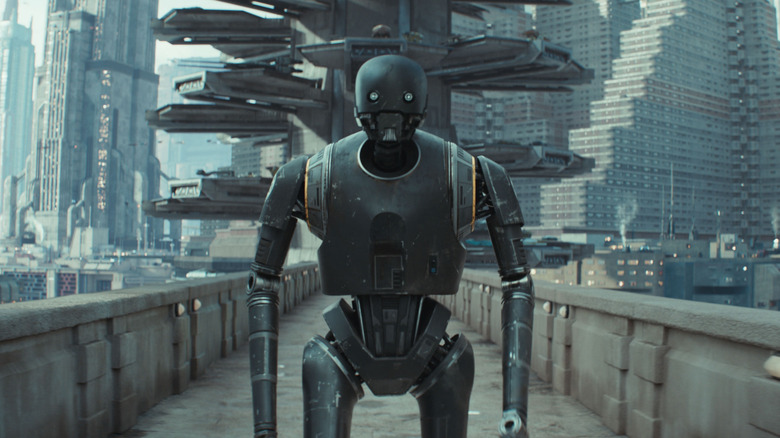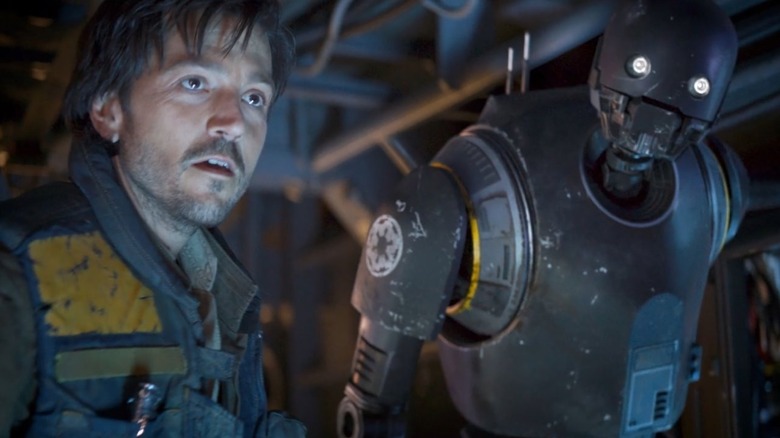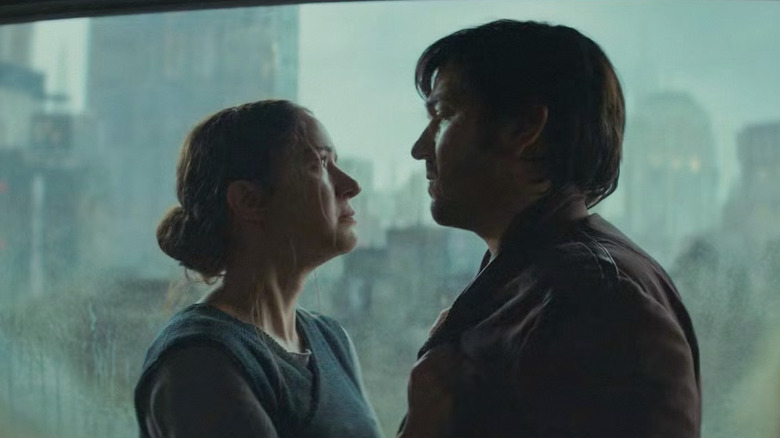Why Andor Creator Tony Gilroy Changed Star Wars Canon For K-2SO's Origin
Spoilers for "Andor" to follow.
A long time ago in a studio far, far away, the Disney+ "Star Wars" series "Andor" was conceived as a show following the Rebel Cassian Andor (Diego Luna) and his reprogrammed Imperial droid partner K-2SO (Alan Tudyk) on their adventures across the galaxy. As the 2016 film "Rogue One: A Star Wars Story" had introduced Cassian and K2 by showing the end of their partnership, this series would explore the beginning.
Tony Gilroy — the credited writer (and uncredited reshoots director) on "Rogue One" who eventually created the "Andor" we all know — took a different approach. Speaking to Deadline in 2023, Gilroy compared one of the show's early iterations to the 1969 Western "Butch Cassidy and the Sundance Kid," i.e. two outlaw friends on the run who rib each other plenty along the way. Butch and Sundance have inspired "Star Wars" in the past, too.
Gilroy said this early draft was "incredibly well done," but that the premise was also "totally limiting and claustrophobic." So, he pitched an "insane" take to Lucasfilm President Kathleen Kennedy and unintentionally got himself the job running "Andor."
Gilroy's "Andor" is much more of an ensemble piece than it sounds like the early versions were. The first season is about how Cassian becomes a Rebel, not in a laborious way but rather because "Andor" is a story about different people living under a dictatorship who respond to and learn from that life experience in different ways. In an interview with /Film's Ben Pearson for "Andor" season 2, Gilroy diagnosed the "fatal flaw" of the early drafts or "Andor" as the story not taking its time and rushing right into the adventure:
"[If] we're going to storm the Citadel in the pilot, what are you going to do in episode 9? What do you do? You're just going to keep getting the disc?"
So, Gilroy purposefully held off on introducing K2, who is absent in season 1 (though there's a scene where Cassian is roughed up by an Imperial droid to foreshadow K2). K2 only showed up in the back half of season 2, and even then, he only had his familiar personality in the final three episode arc. As for the 2017 comic "Star Wars: Rogue One — Cassian & K-2SO Special" #1, which had already shown how the two met and K2 joined the Rebellion? Gilroy decided he wasn't going to structure his whole second season around accommodating that single comic.
On the "Happy Sad Confused with Josh Horowitz" podcast, Gilroy explained:
"Canon, I usually try to deal with it and I'm really sympathetic and into it, [but] I was annoyed to find out that somebody in the interim between 'Rogue' and ['Andor'] had written an origin story for K-2SO. And it's like, 'No, I'm not paying attention to that.'"
Once again, Tony Gilroy is completely right.
K-2SO's different origins in Star Wars explained
In the aforementioned comic (written by Duane Swierczynski and penciled by Fernando Blanco, with a cover drawn by Julian Totino Tedesco), Cassian is on a mission to the planet Wecacoe when he runs into K2, deactivates him, and then reprograms him. In the last page of the comic, they're flying in the getaway ship to their future together.
Maybe another showrunner would've used this comic as the basis for an "Andor" episode, perhaps even the pilot, but not Gilroy. In "Andor" season 2, episode 8, "Who Are You," the Empire rolls out KX model droids in the Ghorman massacre. One of them silently attacks Cassian before the Rebel Samm (Abraham Walper) rams and bisects it with a transport. Cassian, thinking the droid could be useful, brings it back to the Rebel Alliance base on Yavin 4.
Unlike the comic, Cassian doesn't personally reprogram the droid, but the next episode, "Welcome to the Rebellion," ends with K2 awakening. Whereas Swierczynski depicted K2 as already having his sense of humor while serving the Empire (like telling Cassian that he seems "very eager to be arrested"), in the show he has no dialogue until the Rebels reprogram him.
The "Andor" version of events is superior, but that's not the only reason why Gilroy was right to change it. As much as fans like to believe "it's all connected," in a multimedia franchise like "Star Wars," there needs to be layers of canon so that storytellers aren't too tripped up by minor tie-in comics or video games. Films and TV shows should take precedence here because that's what most people see. Few people who watched "Andor" ever read the "Cassian & K-2SO" comic, and fewer still cared that the series didn't recreate its events.
From his comments on "Happy Sad Confused," it sounds like Gilroy felt some ownership over the "Rogue One" characters, too, and wanted to tell their story his way. But at the same time, it's clear he isn't purposefully out to blow up "Star Wars" canon.
Gilroy has admitted he's not a "Star Wars" fan — in that aforementioned Deadline interview, when asked about the chance to "expand on the canon," he replied, "It would be disingenuous for me to say that there was some burning desire or some issue that I wanted to rectify in the 'Star Wars' canon."
But Gilroy also said that he saw "Star Wars: Episode IV — A New Hope" when it first came out in 1977, and it seems like he appreciates what a cultural touchstone the property is. His way of doing it justice wasn't to simply recreate or homage parts of other "Star Wars" projects but by making "Andor" the best show it could be.
In Star Wars, storytelling must come before canon
In the post-George Lucas era, Tony Gilroy has been the only filmmaker besides Rian Johnson who's had more than "Star Wars" on his mind while making a "Star Wars" project. As Gilroy told Deadline:
"My attitude [toward the series] was everything has to be real. I've done all kinds of movies and fixed movies. My whole thing is it's got to be real, it's got to be vivid, you've got to really be desperate to know what happens next. And if I can hit those three, and I can break your heart in the bargain, that's what I'm going for. ... As long as you're making up things that are interesting, and consistent, and really non-cynical and really detailed, and really fascinating, and as long as they don't violate some basic thing [in canon]. I'm just creating canon every episode."
When writers do fixate too much on existing canon, it can actually work to stories' detriment. The other live-action Disney+ "Star Wars" TV shows have basically become a cameo carousel. Ahsoka Tano (Rosario Dawson) teaming up with Din "The Mandalorian" Djarin (Pedro Pascal) can be exciting, but it and similar crossovers makes the galaxy far, far away feel small and incestuous. "Star Wars" has been chasing the high of Darth Vader (James Earl Jones and David Prowse) being revealed as Luke Skywalker's (Mark Hamill) father ever since "The Empire Strikes Back." Really, the franchise should've realized the "secret relative" card is one you can and should pull only once.
"Andor" realizes this, which is why it focuses on building out Cassian's story, revealing he had a life and relationships before we met him in "Rogue One." Existing characters like K2 and Director Orson Krennic (Ben Mendelsohn) only came in when it served the story, while "Rogue One" characters who wouldn't have made "Andor" better, like Jyn Erso (Felicity Jones), didn't show up. Sure, it feels a little weird now that surviving "Andor" characters like Bix (Adria Arjona) and Kleya (Elizabeth Dulau) aren't in "Rogue One," but "Andor" would've been a lesser series without them.
Canon should only ever work to enhance stories, not constrain them. When it becomes the latter, disregard it as Tony Gilroy did on "Andor."
"Andor" is streaming on Disney+


